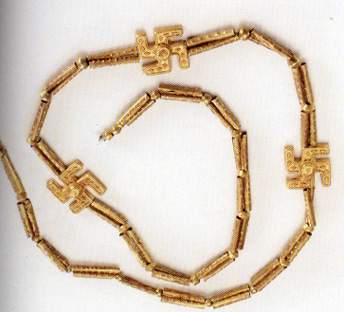29.3.12
Swastika
The swastika or tetra gammadion is a religious and philosophical symbol used since the Neolithic. The word derives from the masculine noun of the same term which means “everything is all right”. It is linked to religious cults such as Buddhism and Hinduism. Members of the National Socialist German Workers’ Party (Nazi) employed it as a political symbol.
A suástica ou cruz gamada é símbolo religioso e filosófico usado desde o Neolítico. O vocábulo deriva do substantivo masculino do mesmo nome onde significa “vai tudo bem”. Encontra-se ligada a cultos religiosos como o Budismo e o Hinduísmo. Os membros do Partido Socialista dos Trabalhadores Alemães (Nazi) empregaram-na como símbolo político.
Unknown (1000 BC)-'golden swastika necklace' Teheran-National Museum of Iran (from Marlick)
Unknown (720 BC)-'swastika (the snakes on handles mark a funerary present)'-kantharos-Attic Berlin-Staatliche Antikensammlungen (8501)
Unknown (700-650 BC)-'swastica'-Etruscan pendant from Bolsena
Unknown-'swastika (solar and tetragammadion simbol)'-doll-Achean Paris-Musée du Louvre
Unknown (1th century AD)-'swastika'-Roman mosaic Volubilis (Morocco)
Labels:
Swastica
Subscribe to:
Post Comments (Atom)





No comments:
Post a Comment